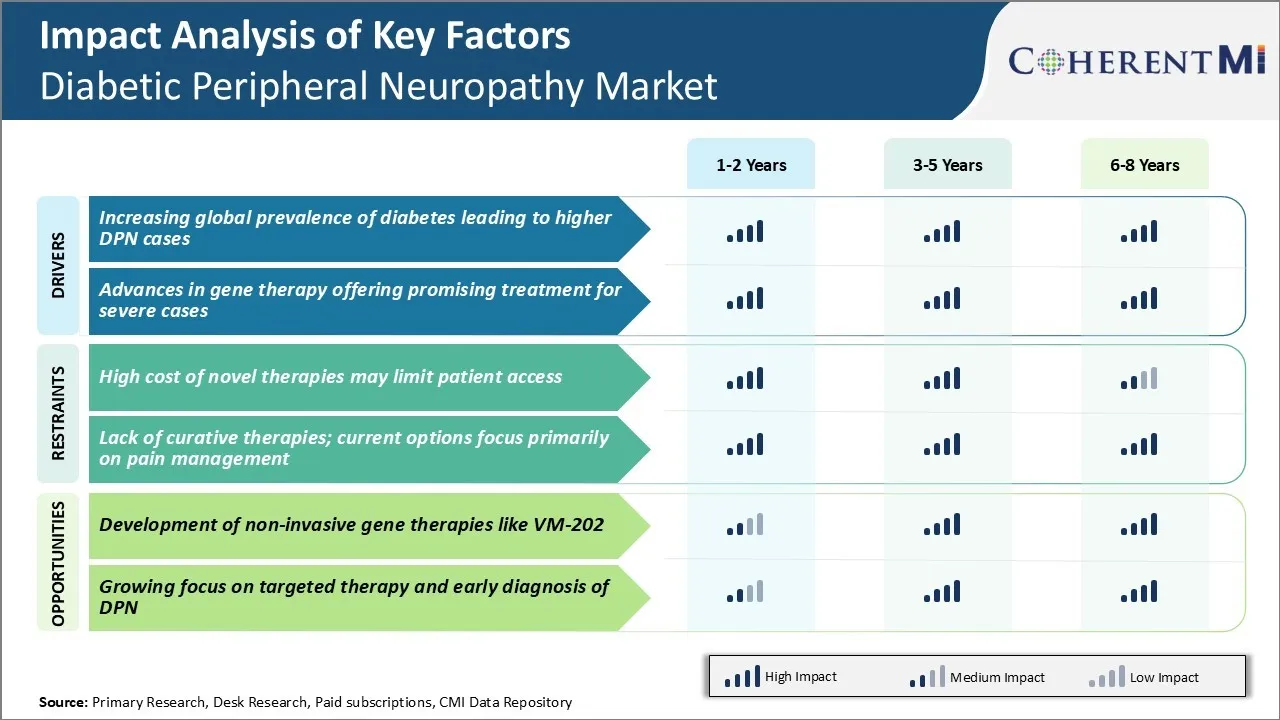Diabetic Peripheral Neuropathy 시장 규모 및 점유율 분석 - 성장 추세 및 예측 (2024 - 2031)
Diabetic Peripheral Neuropathy 시장은 치료 (Pain Management Drugs, Gene Therapies), 질병 (Type 2 Diabetic Peripheral Neuropathy, Type 1 Diabetic Peripheral N....
Diabetic Peripheral Neuropathy 시장 트렌드
시장 드라이버 - Diabetes의 Global Prevalence가 더 높은 DPN에 납땜 사례 연구
WHO의 최근 추정에 따라 전 세계 당뇨병을 앓고있는 420 백만 명이 넘는 사람들이 지난 수십 년 동안 침략을 증가했습니다. 또한, 이 번호는 당뇨병 부담을 curtail로 복용하지 않는 경우 2045 년 약 630 만에 에스컬레이트로 계획됩니다. 이 stark 투상에 의해 경보, 공중 보건 공식 및 연구원은 인식을 확산하고 당뇨병 자체 관리 촉진하기 위해 노력하지 않습니다.
그러나 당뇨병은 의료 인프라 및 접근성이 불균형 인 신흥 경제부의 광대 한 swathes의 광대 한 swathes에서 크고 파괴 된 상태를 유지한다. 점점 더 많은 사람들이 다양한 매크로 요소의 상호 작용을 통해 당뇨병을 개발, 그들의 증가 수는 그들의 질병 진행의 과정에서 당뇨병 neuropathy 증상을 경험하기 위해 지속됩니다. 이 연구에서 evident는 진단된 diabetics 중 대략 8%에서 13%에 배열하는 DPN prevalence 상승을 보고합니다.
DPN 관리 및 멀티 시스템 합병과 관련된 의료 비용은 전 세계적으로 큰 경제 부담이되었습니다. 전 세계 인구가 당뇨병 위험을 높이기 위해 더 많은 투자와 의료 혁신을 완화하는 것은 당뇨병 환자의 신경 손상을 방지하기 위해 필수적입니다.
Market Driver - Severe Cases에 대한 Promising 치료를 제공하는 유전자 치료의 진보
유전자 치료는 치료에 저항하는 DPN 케이스를 포함하여 현재 incurable 상태의 처리 paradigm를 혁명시키기를 위한 거대한 약속을 붙드는 가장 매혹적인 정맥의 한으로 출현했습니다. 지난 수십 년 동안 과학자들은 광범위한 연구를 통해 DPN의 신경 세포 재생 및 증상에 기여하는 분자 경로의 깊은 이해를 얻었다. 이것은 유전자 치료 벡터를 사용하여 변형 될 수있는 새로운 목표를 식별하고 신경 퇴행 과정을 느리게합니다.
실제로 탐구되고 있는 절단 가장자리 기술의 몇몇은 neuropathic 고통 기계장치에서 관여된 고통 치료 유전자의 overexpression를 금하는 antisense oligonucleotides 또는 RNA 방해 기술을 사용하여 유전자 녹아웃 접근입니다. AAV와 lentivirus와 같은 바이러스 벡터는 neuron 생존과 기능을 승진시키는 neurotrophic 단백질 같이 정확한 유전자 또는 요인을 전달하기 위하여 운반대로 평가됩니다. 동물 연구에서 처음 안전과 효능 결과는 매우 encouraging을 봅니다. 치료제로 몇 가지 새로운 유전자 후보는 활성 preclinical screening의 밑에 있습니다.
종합 평가 및 잠재적 인 승인을 위해 몇 년을 걸릴 수 있지만, 유전자 치료 필드는 획기적인 범위를 보유하고 있습니다. 성공적인 이야기는 미래의 DPN의 심한 만성 형태에 대한 의료 패러다임을 혁명 할 수 있습니다.

시장 도전 - Novel Therapies의 높은 비용 5 월 제한 환자 액세스
당뇨병 주변 신경병의 과정을 잠재적으로 수정할 수있는 소설 치료의 개발은 환자의 치료 옵션을 증가했다.
그러나이 새로운 치료는 비 opioid 진통 치료, 유전자 치료 및 줄기 세포 치료와 같은 접근은 종종 높은 가격표를 가지고 있습니다. 우리의 분석에 따라, 새로 승인되고 늦은 파이프 라인 약물의 비용은 환자 당 $ 10,000에서 $ 50,000 사이의 범위, 치료 년 당.
이 치료는 신경병 증상 개선 및 임상 시험의 진행 감소에 대한 이점을 입증했지만, 높은 비용은 광범위한 채택을위한 상당한 장벽이 될 수 있습니다. 대부분의 개인 및 공공 약물 계획은 이러한 비싼 치료에 대한 적용에 엄격한 제한이 있습니다.
치료 옵션의 다른 표준을 실패 한 매우 심각한 증상을 가진 환자는 적용을 위해 승인 될 가능성이 있습니다. 이 한정된 접근은 당뇨병 주변 신경병에서 고통받는 환자의 대다수가 gabapentin와 duloxetine와 같은 일반적인 약물에 의존하지 않을 것입니다 증상 완화에 효과적이지만 질병 진행을 수정하지 않습니다. 신약의 높은 비용 따라서 긴 실행에 질병의 중요한 도전 hampering 효과적인 관리의 한 남아.
시장 기회 – VM-202와 같은 비침범성 유전자 치료의 개발은 기회 제공
Diabetic peripheral neuropathy 시장에 있는 미래 성장을 위한 높은 잠재력을 제공하는 지역의 한개는 비침범성 유전자 치료의 발달입니다. VM-202, 늦은 임상 시험을 겪는 조사적인 화제 유전자 치료는, 잠재적인 비침범성 처리 선택권으로 매력적인 기회를 선물합니다. 승인되면 VM-202는 당뇨병 주변 신경병에 대한 최초의 비 체계 유전자 치료가 될 것입니다.
예비 임상 결과에 의하여, VM-202의 단 하나 신청은 환자의 대다수에서 6 달 또는 더 긴을 위한 고통 구호를 제공했습니다. plasmid DNA의 침투를 통해 비침범성 납품 방법은 다른 유전자 치료에 요구되는 바이러스성 벡터의 반복적인 행정 보다는 그것을 더 안전한 만듭니다.
환자에 의해 관리되는 외래 치료로, VM-202는 또한 매달 주입 치료 보다는 더 비용 효과적이기 위하여 약속합니다. 작은 섬유 neuropathy를 표적하는 활동의 그것의 유일한 기계장치는 또한 질병 수정 치료로 희망을 제공합니다. 호의를 베푸는 안전 단면도로 지금까지와 강한 unmet 필요, VM-202는 승인에 diabetic 주변 neuropathy 시장의 뜻깊은 몫을 관통하는 잠재력을 가지고 있습니다.